American Sabbatical 89: 4/9/98
Etowah
4/9 .. Etowah to Paradise Gardens.
Like Sherman, we burned through Atlanta, not even stopping for a Coke. We saw enough to be certain that
the Yankees won the war. Industrial civilization has eradicated
any lingering vestige of an agrarian society, and paved it over.
Some days I could wish Johnny Reb had come out on top.
We kept on spinning. Up the rising topography. The land lumps
up north of Atlanta, and you realize that once Sherman and the
Army of Tennessee made it through the mountain barrier there was
a broad easy way to the sea. Going uphill we are quickly exchanging
June for May. The hardwood leaves in all their juvenile tints,
the oaks and ashes just unfolding, the rest just taking on their
defining shapes.
We tried to dodge the highroad, but everything was stop and aggro.
Even on the secondaries Georgia drivers are as aggressive as Angelenos,
and you best keep a sharp eye in the rearview for incoming muscle-cars.
From Marietta to Cartersville the stripmeisters have made their
mark.. new malls and housing tracts are cutting into the outlying
hills, raw wounds in the red clay. Backhoes and forms crews. Piles
of trusses and big spools of utility wires.
| To make up for our unforgivable lapse in Atlanta, we stopped at
the site of the first outdoor painted Coca-Cola sign in America.
In Cartersville, on the side of a local pharmacy, in glorious
red and white, there it is. It says Coca-Cola. Put that in your
straw and... Inside, the place smelled like it has been a drug
store for an hundred years, and you could buy authentic antique
replicas of Coke paraphernalia. Isn't America wonderful? |
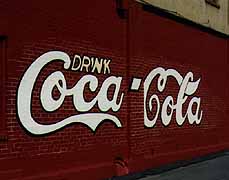 |
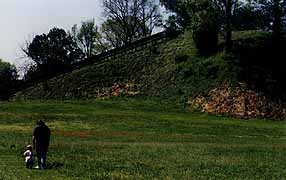
Human Scale
|
Out through the treelined streets and beyond the bungaloed suburbs
we found our way to the Etowah Mounds, another sideroad out of
time. Only three big mounds, this time, but so situated as to
give you a strong sense of what it might have been like to live
here a thousand years ago. Sited by the banks of the Etowah river
in open meadowlands, Etowah has a human scale. The flat-topped
pyramids are still astonishing public works, but they are in tune
with the folded landscape around them.
|
Looking west from the top you can see the triple cooling towers
of another power place, in this nuclear age. The heights of Cahokia
reveal the golden arch of the West, and the industrial wastelands
of East St. Louis. Ocmulgee overlooks Macon. Now Etowah and the
nukes. The syncopation of these ancient rhythms with the contemporary
beat is wonderfully anachronistic. |

Power Places
|
(Memo #83)
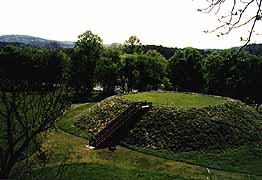
Etowah
|
April 9 Etowah Mounds
Who?Prehistoric Mississippian people of northern Georgia
What? mounds + village
When? A.D. 1000 -1500.
How? advanced agriculture plus hunting-fishing
Topics: prehistory, mound sites, Mississippian culture
Questions: What are the common characteristic of Mississippian
peoples? What are the differences between the far flung sites?
What happened to the Mississippians and how do they relate to
the tribes the English colonists found? |
| We’ve seen four widely dispersed Mississippian mound sites (in
Illinois, Florida, now Georgia). We hope to see more in the western
reaches of the culture area. Ocmulgee is on a plateau cut by ravines
near a small river, Cahokia in a flat floodplain near the Mississippi,
Lake Jackson in the flats by a lake. Etowah is on a grassy plain
by a small river. We’re getting a sense of the overall culture
plus the hierarchy of towns and leaders. There is an obvious difference
in scale, from smaller Lake Jackson and Ocmulgee towns to the
larger Etowah to the immense city of Cahokia. |
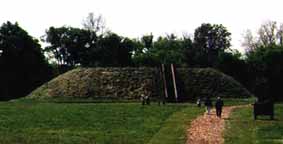
Here come old flat-top
|
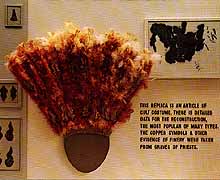
Ceremonial Headress
|
The Mississippian towns are all in river valleys with sandy loam
for crops and mounds and varied resources, where two natural zones
meet. The Mississippians were better farmers than their ancestors
(with better strains of corn), and their food production supported
bigger town populations, a multiclass society with an elite, and
specialized craftsmen. There were far ranging trade routes that
brought raw materials from all parts of the American heartland.
They were organized politically into CHIEFDOMS (loose political
units of several villages with a paramount chief). Different chiefdoms
inhabit different valleys. |
| There was an excellent small museum at Etowah which made the life
of the people in the palisaded and ditched town very real. The
people at Etowah grew corns, beans, squash, pumpkins,sunflower,
tobacco; they gathered acorns, hickory nuts, walnuts, persimmons,
grapes, crustaceans; they hunted bear, deer, wild turkey, fish.
There are remnants of stone and bone tools, of ornaments of copper
and feathers, of game discs and “pucks” for playing “chunky”,
stone bowls and pipes. Trade is shown by conch shells from Florida
and flint from the Nashville area. Etowah produced a variety of
pottery and some wonderful marble statues (four feet high, 125
pounds) of a sitting male and female. They look quite like sitting
Buddhas and I am bemused that we must label with words that divide
- they are called "effigies" at Etowah which suggests a ritual
context (like any religious statue). |
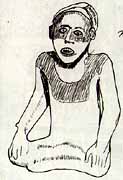
Effigy
|
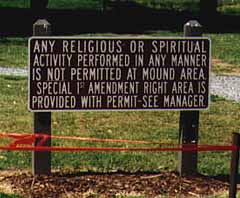
Civil Rights
|
A rather bizarre touch was a sign by the entrance to the site.
“Religious or spiritual activity performed in any manner is NOT
permitted at mound. Special First Amendment rights area is provided
with permit - see manager”. What had been going on? Were “effigies”
involved?
|
The walk at Etowah goes across the village’s ditch and by a reconstructed
section of the palisade that surrounded the village (upright poles
set into the ground side by side). Then you approach the two large
mounds with the 52 acre village area and town plaza (300 feet
square) off to the left. Two smaller mounds were topped by the
residences of leaders and there was a burial mound with many many
remains. I mentally add the smell of open fires, the sounds of
dogs, children, people talking, stone axes on woods, “chunky”
being played in the plaza. From the top of the large mound (63
feet high, 2.9 acres at the bottom and .5 acre at the top) there
is a view of green hills and pastures and the small river and...
a nuclear power plant off to the west!
|
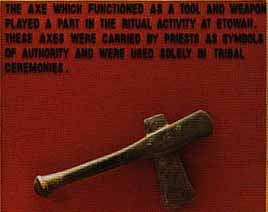
Ritual Axe
|
One of the neatest parts of the village is seen from the river
bank. The people built a stone weir in a huge V across the river
that directed the fish into basketry traps at the mouth of the
V. It can still clearly be seen.
DeSoto (with his 600 men, priests and large pig herd!!) probably
visited this town. Journals from his trip mention “Itawa”, and
they have found iron axes and a sword hilt here.
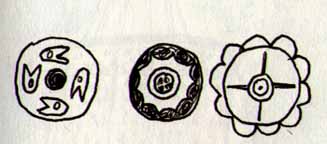
It is difficult to get a firm grasp on the changes from the Mississippian
peoples to the later tribes. Over-exploitation of the environment
probably doomed the largest cities like Cahokia. The earliest
Spanish explorer in the 1500’s found some Mississippian towns
and brought diseases which decimated the North American population.
Huge numbers of people died. Ironically the trade network which
provided such rich materials spread the diseases through the Mississippian
basin The large mound town sites were abandoned. Smaller villages
were settled with a looser tribal organization. It is these town
dwelling tribes (Creeks, Cherokees, Apalachee, etc.) with agriculture
plus hunting that the early Anglo settlers and frontiersman in
the southeast contacted. Archaeologists have decided that the
descendants of Etowah are the living Creek and Muskogee Indians
(who, incidentally, have visited the site and approved of the
presentation).
We go on to the Cherokee heartland. The Cherokees came after the
Mississippian people and had some centuries of development before
the whites came in and, eventually, removed most of them from
the area by force on the Trail of Tears.
4/9.. contd.
Red’s navigator piloted us downstream (west) to the Chieftains’ Museum, with a riverside interlude
of squirrels and fresh challa. We picnicked on the banks of yet
another branch of the Coosa, the Oostanaula. A couple of guys
in a bassboat with a big Merc on it were trying to find their
way up the churning mudrun, slapping against the standing waves
below a bridge, trying to read for snags. The Oostanaula makes
the Cathance seem pellucid and calm. I’d never seen red whitewater
before.
While Peggy DID the Chieftains museum I visited with some elder
Georgians: Augustus Baldwin Longstreet, Wiliam Tappan Thompson,
and Francis Robinson, nineteenth century regional writers of the
tongue-in-cheek variety. Longstreet is credited (by DeVoto, among
others), as being one of Twain’s prototypes: a newspaperman turned
humorist.. if you didn’t get the joke the first time. He collected
his dialect tales of the smalltown Georgia frontier in GEORGIA
SCENES in 1835. I’d read those sketches during my library journeys
last year, and been struck by the enduring tradition of the shaggy
dog story in patois... from before Longstreet (no doubt) down
to the rural storytellers of today. Tim Sample and that lot. Now
I’m reading a collection of “Georgia” writers. I was smiling broadly
when Peggy came out all Chieftained up.
| We were on the outskirts of Rome, surrounded by seven hills, and
soon discovered why the town is so called. Trying to get on the
road to Armuchee and the Chattanooga National Forest we found
that all roads lead back to Rome. Every street we tried either
circled back or deadended. There are some grand Victorian piles
in Rome, and some brokendown backstreet bungalows that could use
a lawn ornament or two. Finally we went south of town and took
the bypass all the way round to make our escape from the Appian
Way. |
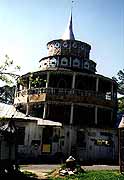
Finster's Spire
|
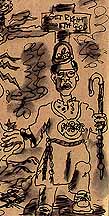
Hisself
|
We’ve been checking our guides and lists for visionary sites,
but seem to have missed most of them. St. EOM’s Pasaquan was just
outside Columbus, but we got lost in presidential peanut country,
so we were excited when we realized that the Reverend Howard Finster’s
Paradise Gardens were just a few miles ahead. Finster’s paintings
have become prized collectibles, as naive art has come out of
the backyard and into the museums. Beaucoup bucks in primitive
painting and collage these days, if you play your naivete right.
We saw a charge of his work at the Visionary Museum in Baltimore,
but here was the horse’s mouth. |
| ‘Course it ain’t on them state maps, yit. In fact the locals we
asked in Summerville weren’t real sure where it was either. We
finally got directions from a MomandPop shop.. from Mom, I guess.
Take a right between two auto parts houses, across the road from
a cement kitsch outlet, at the bedraggled end of town. Two blocks
in, among dilapidated trailers and sagging single families, Howard
Finster has elaborated a self-made universe. |
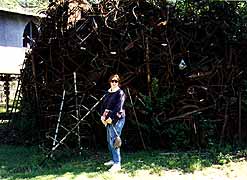
Herself - with bikes
|
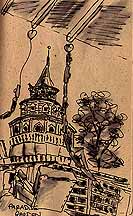
Paradise by Bryce
|
You may remember that Finster had a vision of his dead sister
descending as an angel, inspiring him to spread the divine word
through his art. Here, all too soon, we have the test case of
spiritual content producing the highest art. The Rev. H. may be
the most prolific painter since Lascaux. He numbers and dates
each work and is now up there in the burgers sold numerology.
Almost every one has Biblical quotations blocked in, and his signature
angels drifting down from on high. His cartoon figures of iconographic
personalities... Jesus, Elvis, Himself... are wonderfully crude.
And, frankly, I find them horrible. Excruciating to look at. You
have to be a believer. |
Considering the prices a Finster now fetches, there must be a
lot of them out there. In fact, a lot of the cupboards at Paradise
Gardens were bare. Places where originals had been removed for
gallery shows, no doubt. Although in the overall astonishment,
what’s a few 5 finger paintings... er figure.
Careful, Bryce, you’re treading on thin ice. Ever since we published
LAWN WARS, our field guide to lawn ornamentation (with 16 tacky
postcards in LIVING COLOR), we’ve had this love-hate thing with
outsider art. The raw impact of vernacular installation still
wows me. Show me an inspired dooryard, and you’ve cheered my day.
But documenting and collecting what should be ephemeral enthusiasms,
and putting big tickets on them...
|
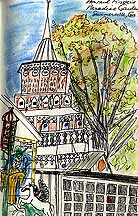
Peggy's Paradise
|
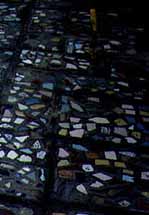
Illuminated Pavement
|
Well.. Finster’s dooryard IS miraculous. Now encompassing an entire
block, caged in cyclone fencing, Paradise Gardens is a fun house
of plywood, paint, cement, and found objects. Cement walkways
embedded with shards of mirror, bits of plastic, enameled metal.
Massive pillars of cemented artifacts, dolls, toys, autoparts.
A rickety elevated arcade knocked together out of 2X4s and luan
makes a U-turn between the encrusted houses. The arcade features
gothic cutout windows, religious cartoon messages painted outside,
and a collection of thematic encrustations within. There is the
largest pile of old bicycles in North America, just saying, well..
just. The engulfed buildings are all covered with paintings and
messages, many featuring the angelic Finster himself, and have
applique delights affixed. One central structure rises up to a
four story pagoda with a cylindrical spire. It’s like a gigantic
aluminum wedding cake glittering up to heaven. The complete experience
IS inspiring. Our neighbors may not be prepared, however.
|
I won’t sneer at Finster’s sacred calling to a personal artform.
Except for craftsmanship, how does this differ from Dali, who
created his own archisculptured environment in Spain? The details
may make you wince, but these visionary worlds overwhelm you with
their sheer profusion, their ecstasy in encrustation, their insistent
celebration of stuff.
|
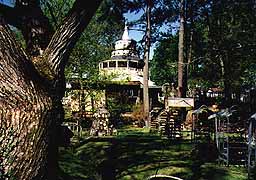
In the Garden
|
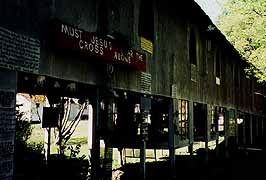
The Rev's Gallery
|
The other American deity is worshipped here, as well: the fast
buck. It costs you $6 a head to wander in the compound, and you
are funneled through a houseful of collectables, at miraculous
prices. The Rev. doesn’t hog the market, though. He has family
members, friends, and neighbors knocking out visionary art in
His style, available at reduced prices. Postcards $1. I’m reminded
of Phil Barter way Downeast, who has a cottage industry churning
out original Barters in a technicolor environ. Wonderful paintings,
by the way.
|
| A couple of locals were leaning against the outside of the fence,
watching us with what looked to be fearful fascination. Who would
pay to come see this stuff? There was also a private B&B in the
main gallery house. $65 a night. We were severely tempted. But
pushed on for the Forest, goggle-eyed. |
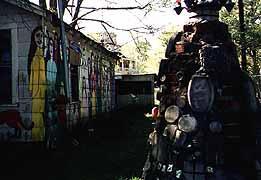
It's in the details
|
Sloppy Floyd’s, to be exact. A Georgia State Park. Once again,
the state camping facilities have it all over the Feds and the
private sector. We drove a couple miles off the through road to
the Park, then another mile into the camping area. Large sites,
with running water and AC, close to the HOT showers, and washer-dryer.
Everything immaculate and in working order.
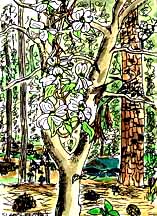
Sloppy Floyd's
|
The contrast to the roadhovels we’ve been staying at made us sigh
deeply. Our site was in a lofty grove of loblollys with an understory
of scattered dogwoods. The dogwoods are in bloom in the Georgia
mountains, and the explosions of white blossoms among the loblolly’s
plumb trunks of graybrown plated bark was the finest art of all.
Nature is so prolific. Dogwood petals and the unfertilized fruits
of the loblollys rained down on us. The evening sky was cluttered
with pendulous pinecones and the canopy of needles. We smiled
at the childish energy with which the young loblollys sent up
tall candles, bristled with long needles, and reached for the
sky. The ground was littered with chunks of limestone among the
cast needles and seasonal euphoria. A new moon cusped the sky,
and we feasted and fell down.
|
When the breeze died away we heard the highway roaring off through
the hills, and the temperature fell toward freezing. We’d come
back to Spring, but not escaped Thunder Road. Way out in the Mojave
it was a necklace of lights, here it was the rumble of commerce.
So much for wilderness.



















